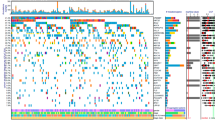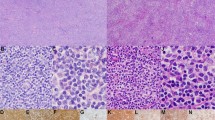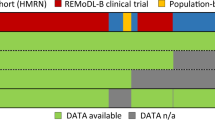Abstract
Follicular lymphoma (FL) is characterized besides the t(14;18)(q32;q21), by recurrent chromosomal alterations and somatic mutations. In this study, we analyzed cases of FL in situ (FLIS) without manifest FL (mFL), partial involvement by FL (PFL) and paired cases of FLIS and mFL to detect possible early chromosomal imbalances, mutations, as well as DNA-methylation patterns of genomic regions of selected genes. We demonstrate that all paired FLIS and mFL cases were clonally related, based on IGH rearrangement patterns and BCL2 breakpoint sequences. FLIS and PFL had no or few secondary chromosomal imbalances detectable by array comparative genomic hybridization (FLIS 0.8 copy number alterations (CNA)/case; PFL 2.0 CNA/case; mFL 6.3 CNA/case) and a lower level of DNA methylation of genes recurrently de novo methylated in lymphomas, as compared with mFL. EZH2 Tyr641 mutations were detected in a subset of both FLIS (2/9) and PFL (1/3) cases. In conclusion, these findings provide evidence that FLIS represents a FL precursor lesion of long-lived clonal B cells carrying the t(14;18) with no or few secondary genetic changes. Our data suggest that there may be more than one distinct lesion driving the progression from FLIS to manifest lymphoma.
This is a preview of subscription content, access via your institution
Access options
Subscribe to this journal
Receive 12 print issues and online access
$259.00 per year
only $21.58 per issue
Buy this article
- Purchase on Springer Link
- Instant access to full article PDF
Prices may be subject to local taxes which are calculated during checkout





Similar content being viewed by others
References
Swerdlow S, Campo E, Harris NL, Jaffe ES, Pileri SA . World Health Organization Classification of Tumours. WHO Classification of Tumours of Haematopoietic and Lymphoid Tissues. IARC Press: Lyon, 2008.
Hockenbery D, Nunez G, Milliman C, Schreiber RD, Korsmeyer SJ . Bcl-2 is an inner mitochondrial membrane protein that blocks programmed cell death. Nature 1990; 348: 334–336.
Horsman DE, Gascoyne RD, Coupland RW, Coldman AJ, Adomat SA . Comparison of cytogenetic analysis, southern analysis, and polymerase chain reaction for the detection of t(14; 18) in follicular lymphoma. Am J Clin Pathol 1995; 103: 472–478.
Tsujimoto Y, Gorham J, Cossman J, Jaffe E, Croce CM . The t(14;18) chromosome translocations involved in B-cell neoplasms result from mistakes in VDJ joining. Science 1985; 229: 1390–1393.
Cheung KJ, Shah SP, Steidl C, Johnson N, Relander T, Telenius A et al. Genome-wide profiling of follicular lymphoma by array comparative genomic hybridization reveals prognostically significant DNA copy number imbalances. Blood 2009; 113: 137–148.
Leich E, Salaverria I, Bea S, Zettl A, Wright G, Moreno V et al. Follicular lymphomas with and without translocation t(14;18) differ in gene expression profiles and genetic alterations. Blood 2009; 114: 826–834.
Dolken G, Illerhaus G, Hirt C, Mertelsmann R . BCL-2/JH rearrangements in circulating B cells of healthy blood donors and patients with nonmalignant diseases. J Clin Oncol 1996; 14: 1333–1344.
Limpens J, Stad R, Vos C, de Vlaam C, de Jong D, van Ommen GJ et al. Lymphoma-associated translocation t(14;18) in blood B cells of normal individuals. Blood 1995; 85: 2528–2536.
Liu Y, Hernandez AM, Shibata D, Cortopassi GA . BCL2 translocation frequency rises with age in humans. Proc Natl Acad Sci USA 1994; 91: 8910–8914.
Bell DA, Liu Y, Cortopassi GA . Occurrence of bcl-2 oncogene translocation with increased frequency in the peripheral blood of heavy smokers. J Natl Cancer Inst 1995; 87: 223–224.
Roulland S, Lebailly P, Lecluse Y, Briand M, Pottier D, Gauduchon P . Characterization of the t(14;18) BCL2-IGH translocation in farmers occupationally exposed to pesticides. Cancer Res 2004; 64: 2264–2269.
Roulland S, Lebailly P, Lecluse Y, Heutte N, Nadel B, Gauduchon P . Long-term clonal persistence and evolution of t(14;18)-bearing B cells in healthy individuals. Leukemia 2006; 20: 158–162.
Cong P, Raffeld M, Teruya-Feldstein J, Sorbara L, Pittaluga S, Jaffe ES . In situ localization of follicular lymphoma: description and analysis by laser capture microdissection. Blood 2002; 99: 3376–3382.
Jegalian AG, Eberle FC, Pack SD, Mirvis M, Raffeld M, Pittaluga S et al. Follicular lymphoma in situ: clinical implications and comparisons with partial involvement by follicular lymphoma. Blood 2011; 118: 2976–2984.
Cheung MC, Bailey D, Pennell N, Imrie KR, Berinstein NL, Amato D et al. In situ localization of follicular lymphoma: evidence for subclinical systemic disease with detection of an identical BCL-2/IGH fusion gene in blood and lymph node. Leukemia 2009; 23: 1176–1179.
Bonzheim I, Salaverria I, Haake A, Gastl G, Adam P, Siebert R et al. A unique case of follicular lymphoma provides insights to the clonal evolution from follicular lymphoma in situ to manifest follicular lymphoma. Blood 2011; 118: 3442–3444.
De S, Shaknovich R, Riester M, Elemento O, Geng H, Kormaksson M et al. Aberration in DNA methylation in B-cell lymphomas has a complex origin and increases with disease severity. PLoS Genet 2013; 9: e1003137.
Martin-Subero JI, Ammerpohl O, Bibikova M, Wickham-Garcia E, Agirre X, Alvarez S et al. A comprehensive microarray-based DNA methylation study of 367 hematological neoplasms. PLoS One 2009; 4: e6986.
O'Riain C, O’Shea DM, Yang Y, Le Dieu R, Gribben JG, Summers K et al. Array-based DNA methylation profiling in follicular lymphoma. Leukemia 2009; 23: 1858–1866.
Morin RD, Mendez-Lago M, Mungall AJ, Goya R, Mungall KL, Corbett RD et al. Frequent mutation of histone-modifying genes in non-Hodgkin lymphoma. Nature 2011; 476: 298–303.
Pasqualucci L, Dominguez-Sola D, Chiarenza A, Fabbri G, Grunn A, Trifonov V et al. Inactivating mutations of acetyltransferase genes in B-cell lymphoma. Nature 2011; 471: 189–195.
Montes-Moreno S, Castro Y, Rodriguez-Pinilla SM, Garcia JF, Mollejo M, Castillo ME et al. Intrafollicular neoplasia/in situ follicular lymphoma: review of a series of 13 cases. Histopathology 2010; 56: 658–662.
Henopp T, Quintanilla-Martinez L, Fend F, Adam P . Prevalence of follicular lymphoma in situ in consecutively analysed reactive lymph nodes. Histopathology 2011; 59: 139–142.
Martin-Subero JI, Gesk S, Harder L, Sonoki T, Tucker PW, Schlegelberger B et al. Recurrent involvement of the REL and BCL11A loci in classical Hodgkin lymphoma. Blood 2002; 99: 1474–1477.
Steinemann D, Gesk S, Zhang Y, Harder L, Pilarsky C, Hinzmann B et al. Identification of candidate tumor-suppressor genes in 6q27 by combined deletion mapping and electronic expression profiling in lymphoid neoplasms. Genes Chromosomes Cancer 2003; 37: 421–426.
Ventura RA, Martin-Subero JI, Jones M, McParland J, Gesk S, Mason DY et al. FISH analysis for the detection of lymphoma-associated chromosomal abnormalities in routine paraffin-embedded tissue. J Mol Diagn 2006; 8: 141–151.
Sotlar K, Escribano L, Landt O, Mohrle S, Herrero S, Torrelo A et al. One-step detection of c-kit point mutations using peptide nucleic acid-mediated polymerase chain reaction clamping and hybridization probes. Am J Pathol 2003; 162: 737–746.
van Dongen JJ, Langerak AW, Bruggemann M, Evans PA, Hummel M, Lavender FL et al. Design and standardization of PCR primers and protocols for detection of clonal immunoglobulin and T-cell receptor gene recombinations in suspect lymphoproliferations: report of the BIOMED-2 Concerted Action BMH4-CT98-3936. Leukemia 2003; 17: 2257–2317.
Stetler-Stevenson M, Raffeld M, Cohen P, Cossman J . Detection of occult follicular lymphoma by specific DNA amplification. Blood 1988; 72: 1822–1825.
Gribben JG, Freedman A, Woo SD, Blake K, Shu RS, Freeman G et al. All advanced stage non-Hodgkin's lymphomas with a polymerase chain reaction amplifiable breakpoint of bcl-2 have residual cells containing the bcl-2 rearrangement at evaluation and after treatment. Blood 1991; 78: 3275–3280.
Albinger-Hegyi A, Hochreutener B, Abdou MT, Hegyi I, Dours-Zimmermann MT, Kurrer MO et al. High frequency of t(14;18)-translocation breakpoints outside of major breakpoint and minor cluster regions in follicular lymphomas: improved polymerase chain reaction protocols for their detection. Am J Pathol 2002; 160: 823–832.
Trainor KJ, Brisco MJ, Wan JH, Neoh S, Grist S, Morley AA . Gene rearrangement in B- and T-lymphoproliferative disease detected by the polymerase chain reaction. Blood 1991; 78: 192–196.
Liu F, Yoshida N, Suguro M, Kato H, Karube K, Arita K et al. Clonal heterogeneity of mantle cell lymphoma revealed by array comparative genomic hybridization. Eur J Haematol 2013; 90: 51–58.
Martin-Subero JI, Kreuz M, Bibikova M, Bentink S, Ammerpohl O, Wickham-Garcia E et al. New insights into the biology and origin of mature aggressive B-cell lymphomas by combined epigenomic, genomic, and transcriptional profiling. Blood 2009; 113: 2488–2497.
Pellissery S, Richter J, Haake A, Montesinos-Rongen M, Deckert M, Siebert R . Somatic mutations altering Tyr641 of EZH2 are rare in primary central nervous system lymphoma. Leuk Lymphoma 2010; 51: 2135–2136.
Roulland S, Faroudi M, Mamessier E, Sungalee S, Salles G, Nadel B . Early steps of follicular lymphoma pathogenesis. Adv Immunol 2011; 111: 1–46.
Horsman DE, Connors JM, Pantzar T, Gascoyne RD . Analysis of secondary chromosomal alterations in 165 cases of follicular lymphoma with t(14;18). Genes Chromosomes Cancer 2001; 30: 375–382.
Adam P, Katzenberger T, Eifert M, Ott MM, Rosenwald A, Muller-Hermelink HK et al. Presence of preserved reactive germinal centers in follicular lymphoma is a strong histopathologic indicator of limited disease stage. Am J Surg Pathol 2005; 29: 1661–1664.
d'Amore F, Chan E, Iqbal J, Geng H, Young K, Xiao L et al. Clonal evolution in t(14;18)-positive follicular lymphoma, evidence for multiple common pathways, and frequent parallel clonal evolution. Clin Cancer Res 2008; 14: 7180–7187.
Green MR, Gentles AJ, Nair RV, Irish JM, Kihira S, Liu CL et al. Hierarchy in somatic mutations arising during genomic evolution and progression of follicular lymphoma. Blood 2013; 121: 1604–1611.
Bödör C, Grossmann V, Popov N, Okosun J, O’Riain C, Tan K et al. EZH2 mutations are frequent and represent an early event in follicular lymphoma. Blood 2013; 122: 3165–3168.
Beguelin W, Popovic R, Teater M, Jiang Y, Bunting KL, Rosen M et al. EZH2 is required for germinal center formation and somatic ezh2 mutations promote lymphoid transformation. Cancer Cell 2013; 23: 677–692.
Ryan RJ, Nitta M, Borger D, Zukerberg LR, Ferry JA, Harris NL et al. EZH2 codon 641 mutations are common in BCL2-rearranged germinal center B cell lymphomas. PLoS One 2011; 6: e28585.
Morin RD, Johnson NA, Severson TM, Mungall AJ, An J, Goya R et al. Somatic mutations altering EZH2 (Tyr641) in follicular and diffuse large B-cell lymphomas of germinal-center origin. Nat Genet 2010; 42: 181–185.
Acknowledgements
We thank Dorit Schuster, Reina Zühlke-Jenisch, Magret Ratjen, Claudia Kloss, Anne Marie Adam and Sema Colak for their excellent technical assistance. IS was supported by a fellowship from the Alexander von Humboldt Foundation. This project is supported by the BMBF HämatoSys network project (FKZ0315452B; RS) and SFB 685 (LQ-M and FF).
Author contributions
LQ-M and RS designed the study, supervised the experimental work, analyzed data and wrote the manuscript. FF designed the study, analyzed data and helped writing the manuscript. JS, IS, AH performed the experimental work and helped writing the manuscript. IB performed and supervised the experimental work. MAP, SM-M and PA provided samples and clinical information.
Author information
Authors and Affiliations
Corresponding author
Ethics declarations
Competing interests
The authors declare no conflict of interest.
Additional information
Supplementary Information accompanies this paper on the Leukemia website
Supplementary information
Rights and permissions
About this article
Cite this article
Schmidt, J., Salaverria, I., Haake, A. et al. Increasing genomic and epigenomic complexity in the clonal evolution from in situ to manifest t(14;18)-positive follicular lymphoma. Leukemia 28, 1103–1112 (2014). https://doi.org/10.1038/leu.2013.307
Received:
Accepted:
Published:
Issue Date:
DOI: https://doi.org/10.1038/leu.2013.307
Keywords
This article is cited by
-
Novel insights into the pathogenesis of follicular lymphoma by molecular profiling of localized and systemic disease forms
Leukemia (2023)
-
Clinicopathological features of in situ follicular neoplasm and relations with follicular lymphoma in Japan
Annals of Hematology (2020)
-
Follicular lymphoma
Nature Reviews Disease Primers (2019)
-
Revidierte Fassung der 4. Ausgabe der WHO-Klassifikation maligner Lymphome
Der Pathologe (2019)
-
From genetics to the clinic: a translational perspective on follicular lymphoma
Nature Reviews Cancer (2018)



